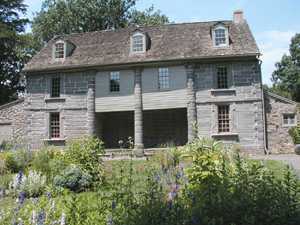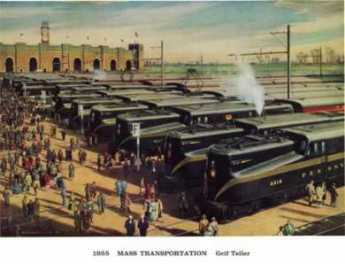Related Topics
West of Broad
A collection of articles about the area west of Broad Street, Philadelphia, Pennsylvania.
Particular Sights to See:Center City
Taxi drivers tell tourists that Center City is a "shining city on a hill". During the Industrial Era, the city almost urbanized out to the county line, and then retreated. Right now, the urban center is surrounded by a semi-deserted ring of former factories.
City of Rivers and Rivulets
Philadelphia has always been defined by the waters that surround it.
Quakers: All Alike, All Different
Quaker doctrines emerge from the stories they tell about each other.
Nature Preservation
Nature preservation and nature destruction are different parts of an eternal process.
Quaker Gardens
New topic 2016-12-04 04:23:55 description
John Bartram's Garden

|
| Bartram Gardens |
It's worth a visit to Bartram's Gardens, if only for the astonishment of finding a very large farm and stone Quaker farmhouse within a few blocks of our largest medical center, a stone's throw from the biggest oil refinery on the upper East Coast. And located on the edge of a neighborhood that is, well, past its prime. The trees on the farm are centuries old, so walking around the grounds imparts the feeling of being hundreds of miles from civilization when in fact you are only a hundred yards away from streets that are very urban, indeed. When you turn in certain directions, an occasional skyscraper peeps over treetops, and down the meadows, at the farm's dock on the leafy-banked Schuylkill, you can see oil storage tanks across the river, just a long shot with a 2-iron away. Look upward, to see the upper half of shining towers of Center City.
The farm property as it now stands dates back to 1728, but the site marks the earliest beginnings of the city, nearly a hundred years earlier. The river curves around this hill then snake on down to Delaware through flatlands which were originally swamps ("wetlands", as they say). The hill is as far downriver into malaria territory as the Indians were willing to go, so the Dutch traders had to sail upriver and dock there in order to take thirty or forty thousand fur pelts back to Holland each year. One thing or another has been dumped on the swamps for three hundred years, and the oil companies found it a cheap place to buy enough land for their refineries, close to four or five railroads near Bartram's place, and with access to the high seas. Right now, most of the oil comes from Nigeria, emptying two or so supertankers a week. There has to be enough storage capacity to take care of delays caused by bad weather on the Atlantic, and there has to be access to railroads and highways to carry the finished product away. The rest of a refinery is just thousands of miles of metal pipes, gleaming in the sun.
Sun Oil is trying to be a good neighbor, turning more and more of the area over to nature preserve, as chemical engineers have learned how to work in a smaller space with fewer employees. The banks of the lower Schuylkill are now mostly grown to shrubs and trees, concealing from boat travelers the rather extensive dumps of old auto tires and similar refuse. It's a placid winding trip, increasingly coming to resemble what the Dutch traders once encountered. Especially in May, when the Palomino or Empress trees are in purple bloom. It seems the Chinese packed their porcelains in dried Palomino seed pods, and the discards have grown up to quite a nice display. Logan Square is filled with such trees, quite artfully pruned and maintained; just imagine several miles of the river lined with them, and you can see why the Tourist Bureau is excited about the potential. If you have been to San Antonio you know the potential of an urban river ride, which in this case might go all the way up to the Art Museum. Given enough public response, you can envision two or three-day barge rides from New Castle, Delaware to Pennsbury, with side trips up past Bartram's to the Waterworks. Right now, trips are comparatively limited by the tides, with a few trips a year down from Bartram's to the refineries, and a few more up to the river to the Art Museum. They use floating docks, and permanent docks will need to be built.

|
| Pennsylvania Railroad |
Originally, the crude oil came from upstate Pennsylvania, near Bradford, and was the main source of the dominance of the Pennsylvania Railroad. Baltimore and New York were also the beginnings of transcontinental railroads, but their freight cars came back empty. The upstate Pennsylvania oil gave the PRR a dominant edge by supplying cargo for two-way revenue.
When George Washington had to retreat from the Battle of Brandywine, the armies had to cross the wetlands, and the river, to get to Philadelphia. Washington got there first and burned the boats after his army got across. He knew, but the British probably did not fully realize, that the first place to ford the Schuylkill was at Norristown. When the British finally got that far, Washington was waiting for them, but a fall hurricane came along and soaked everybody's gunpowder before there could be much of a battle. Unfortunately, Mad Anthony Wayne was unprepared for a nighttime bayonet charge, and there was still quite a slaughter.
You can't wander around John Bartram's house and gardens without getting the impression of considerable wealth. Bartram was interested in botany, becoming the most eminent authority on plants of the Western hemisphere, a very close friend of Benjamin Franklin, and probably the main force behind the creation of the American Philosophical Society. But although Bartram was a hobbyist, he was a shrewd businessman, selling curiosity plants to Europeans, and commercially improved fruits and vegetables to local farmers. There are still some Bartrams around Philadelphia, with a strong Quaker air about them. Around 1850 the place was sold to a zillionaire railroad magnate named Eastwick, who fixed up the place in the high style he learned building the railroads of Russia for the Tsar. The mansion has been torn down, but the stone farmhouse, stone barn, stone sheds, stone outbuildings, stone everything -- endures, like many of the curiosity trees and bushes. Well worth a visit.
Originally published: Wednesday, June 21, 2006; most-recently modified: Wednesday, May 22, 2019
| Posted by: Rayshelon | Sep 7, 2011 12:55 AM |